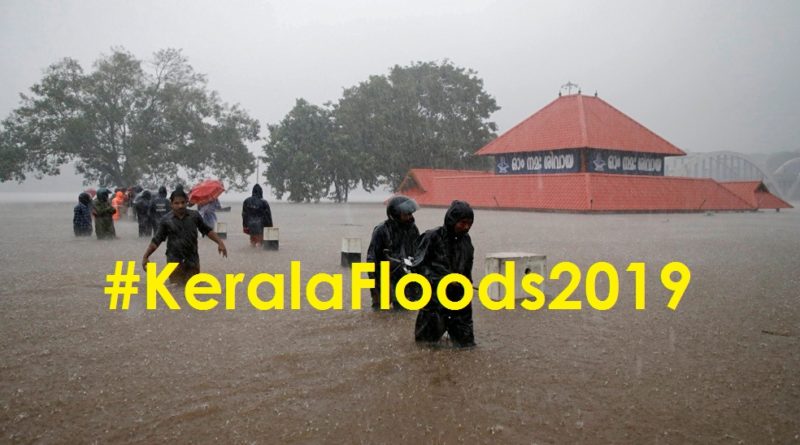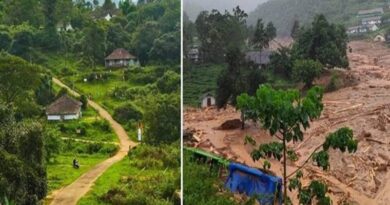As Malabar faces deadly landslides, debate shifts to ecologically sensitive areas and human intervention
Suneesh V., 29, walks gingerly to the tarpaulin-covered front yard of his tiny house as if the earth would give way if he stepped on it a little firmly. He doesn’t seem to trust the soil beneath his feet any longer. He lives on Muthappankunnu hill, covered with young rubber trees, in Kavalappara, which is part of the Bhoodanam colony in Pothukallu panchayat in Kerala’s Malappuram district. This is where landless tribals secured land after the Bhoodan movement more than six decades ago. On the night of August 8, the hill suddenly moved, shaking his faith in it.
The rains had been relentless since August 4, but they turned particularly raucous from August 7, flooding the lowlands of Nilambur taluk in the Chaliyar river basin. Almost all of Pothukallu’s low-lying areas were submerged, forcing people to seek shelter elsewhere.
Water rose at an alarming pace in the thodu (streamlet) at the foot of Muthappankunnu hill as well. Several hill people, including Suneesh, a construction worker, were without work for a few days. On August 8 evening, a clutch of youth in the neighbourhood decided to walk down the road that split the hill in the middle to gauge the situation.
“Word had spread that the Thudimutti bridge, a kilometre downstream on the thodu, was flooded. We went wearing raincoats. The stream was fierce. Last year, when it rained heavily, there was fear of landslides, so the hill people were evacuated to relief camps. But nothing happened. So, we were not particularly alarmed this time around,” recalls Suneesh.
It was already dark when the young men returned. “There was a power outage. My neighbour Priyadarsh, 32, and I stood in front of my house and chatted for a bit,” says Suneesh. “He then decided to go check on his mother and grandmother. Just as he stepped into his homestead, there was a wild rumble from above. It was as though a thousand roller shutters had been slammed down. Fear made me motionless for a while. Moments later, I ran into my house to see my pregnant wife and mother in shock. We did not know what to do,” he says, his voice trembling.
Half an hour later, the survivors on the tiny island of green who had been spared by the landslide gathered on what remained of the road. “We realised we would not be able to cross the swollen thodu. The hill had collapsed and we spent the night in dread in the small courtyard of my parents’ house,” says Suneesh.
As rescue workers struggle to retrieve the bodies of Priyadarsh, his mother Ragini and grandmother Devayani from the debris, Suneesh sits on his haunches nearby, unable to move.
“He is terrified,” says Pratheesh Prasad, 35, Priyadarsh’s brother, who lives in a rented house in Uppada, a neighbouring village. “They all came over to my place for 15 days this time last year. They were thinking of coming again. It’s not my loss alone. Several people have lost their close relatives.”
When the hills collapsed
This month Kerala was battered by an erratic monsoon for the second year in a row. The worst tragedies have unfolded in the hills of Malabar this time: in Kavalappara in Malappuram and Puthumala in Wayanad, separated by just six kilometers across the hills.
There were 125 rain-related deaths in Kerala between August 8 and 21, according to the State Disaster Management Authority. About 65 landslides were reported, mostly in the Malabar region. Following a massive landslide in Kavalappara, 59 people went missing. Till August 21, 48 bodies were recovered. At Puthumala, 12 bodies were recovered and the search continues for the five who are still missing. Across the State, 1,800 houses were destroyed by the floods and 14,500 were partially damaged.
“The landslide in Puthumala was three hours before the one in Kavalappara. The Chaliyar was flooded. The waters swept over the Panankayam bridge near Bhoodanam. As debris containing uprooted trees, masses of concrete and mud got stuck at the bridge, streams nearby, including the Kavalappara thodu, breached the banks. But since the area was marooned and it was still pouring, no one came to know about the Puthumala slide till afternoon the next day. It was then that everyone also came to know about the Kavalappara slide,” says Sivan, 56, a resident of Vellilamadu in Bhoodanam.
Between the Puthumala and the Kavalappara landslides, at around 5.30 pm on August 8, another landslide destroyed the market, community facilities, some 22 houses, a mosque at Pathar, and another ward in the Pothukallu panchayat, a stone’s throw away from Bhoodanam. “Seeing that the water of the Ezhavathodu stream was of a different colour, people had already moved to safer places when the landslide occurred. There was no loss of life, but we lost everything else,” cries Rojimon I.G., 32. “There were eight landslides in the upper reaches, in Valamkolli and Thenpara. Maybe they were triggered by the two granite quarries in the vicinity,” he says, pointing to the sea of debris where his house stood.
“No, it was because of the rain,” argues Barthila Baby, panchayat member from Pathar. “The operation of a quarry nearby had been stopped some time ago.” A village official remembers issuing a stop memo to those illegally mining in Murukanjiram, near Pathar, a few years ago.Barring a laterite quarry on a hill opposite Muthappankunnu hill, there is no granite quarry close by, says Rajesh Dominic, 38, a farmer who survived the landslide. “However, it is a man-made disaster,” he says. “Over a year ago, a planter had come here with heavy earth movers to dig huge rain pits for his rubber saplings. Use of heavy machines at that height, close to the crest of the hill, should have been avoided. The waterlogged pits must have triggered the landslide,” he says.
Muthappankunnu hill had a canopy of cashew groves till a few years ago. These were replaced by rubber. “As farmers, we make sure that we conserve the land. I grow areca nut and banana and make it a point to grow grass to strengthen the soil,” says Rajesh, who had to carry out an eleventh hour evacuation of his ageing parents, pregnant wife and children.
The Pothukallu gram panchayat has now submitteda proposal to the government to rehabilitate all the 270 families from the Kavalappara area, says Valsala Aravindan, Bhoodanam ward member and panchayat vice president. “We have also decided not to allow farming in the hill,” she says.
At Puthumala, once a scenic village on the slopes of plantation estates, Asghar, 32, waits as excavators look for the missing. He says he was among those who protested the operation of a granite quarry close to the area.
“Blasting at the Pachakkad quarry used to be a pain. Rock pieces would hit our houses once in a while. After a lot of struggle, we managed to get it closed,” says Asghar, whose father Aboobacker, 62, a Saudi returnee, is still missing. An early landslide near the abandoned quarry had nearly sunk his two-storey house abutting the road on the lower side of the hill. “Since it was raining heavily, my father went in a car with our neighbour Avaran (68) to take a look. Both are missing,” says Asghar.
Given the torrential rain and crevices in some of the hills above — at Chooralmala, Mundakai and Attamala — Puthumala residents, many of whom are tea and cardamom plantation workers, or their kin, had already been moved to relief camps. “The situation looked ominous from August 7. Some 53 houses, a mosque, a temple, a post office, the houses of plantation workers called paadi lines, a canteen and a children’s play area were later devoured by the landslide. The debris stretched over a 10-km area,” says the president of Meppadi panchayat, K.K. Sahad.
At the relief camp in the Government Higher Secondary School in Meppadi, survivors are traumatised. Nausheena, 27, an advocate, shudders at the memory of her failed attempt to save her sister-in-law, 32-year-old Hajira. “We were alert as water in the rivulet in front of our house was rising. But when the debris hit us all suddenly, there was a mad scramble to get to higher ground. I saw a 7-year-old boy in the neighbourhood clutching onto the sinking pillar of our house and crying for help. I was able to pull him up. My sister-in-law was short and although I stretched out my hand to her, the debris consumed her,” she says. With no place to go, her mother, brother and his two children are moving to a rented house at Kalpetta.
The Meppadi panchayat is seeking patronage to buy some 10 acres of lowland to rehabilitate at least 100 families from Puthumala.
The role of quarries
Kerala was on the path to recovery and rebuilding after the flood in August last year. The flood had also rekindled the debate on whether the State would have been better off had it embraced the Western Ghats Ecology Expert Panel (WGEEP) report of August 2011. Notably, the panel, which was chaired by ecologist Madhav Gadgil, had incorporated the Nilambur-Meppadi hills in the topmost category of Ecologically Sensitive Zones (ESZ-1).
Initial discussions revolved around the role of quarries in rattling the fragile environs of these hills. Based on GIS mapping data, two scientists of the Kerala Forest Research Institute found in 2017 that the State had 5,924 quarries, both active and abandoned ones. “We found that there are 1,486 granite quarries in ESZ-1, 169 in ESZ-2 and 1,667 quarries in ESZ-3 identified by WGEEP,” says the report prepared by T.V. Sajeev and Alex C.J., adding that it was impossible to ascertain whether or not a quarry was functional.
The WGEEP report had recommended a ban on quarrying in ESZs 1 and 2 and also said that existing ones should be phased out in five years. While the Kerala Forest Research Institute report mapped the presence of 12 quarries in a five-km radius of Kavalappara, the tahsildar of Nilambur, Subhash Chandra Bose, says the entire taluk has just three active granite quarries. “It is not the last stone extracted from a quarry that causes a landslide,” says Sajeev.
According to Ali Moideen, chairman of the Quarry Crusher Coordination Committee, with environmental clearances being made mandatory for all quarries, the number of granite quarries in operation in Kerala has come down from nearly 6,000 in 2010 to 728 now. Malappuram accounts for over 100 of them, he says. But no one is disputing the fact that unlicensed, unregulated quarries are also in operation.
A State-wide ban clamped on quarrying in the wake of the landslides has now been lifted, except in Malappuram where the district administration has chosen to continue the ban. In view of the frightening regularity of natural hazards now, the State Directorate of Environment and Climate Change has initiated consultations with other departments and stakeholders to outlaw quarrying in ecologically sensitive regions based on the landslide susceptibility zones mapped by the National Centre for Earth Science Studies in 2010.
The map is being updated now. “The new regulations will also encompass measures to restore abandoned quarries and add teeth to the law against unauthorised quarrying,” says Usha Titus, Principal Secretary, Environment.
Simultaneously, a landslide susceptibility map being readied by the Geological Survey of India has already covered over 13,000 km of the 18,000 km mountain region in Kerala. “It is likely to be ready by the middle of next year. Meanwhile, we are visiting the landslide sites for conducting studies. A similar inventory study was undertaken across 2,000 landslide sites soon after last year’s floods,” says Sachin R., superintending geologist. As many as 5,000 landslides were recorded in the State in 2018.
The need of the hour
A Post-Disaster Needs Assessment conducted by the United Nations Development Programme in the wake of the 2018 floods and the draft Rebuild Kerala road map have made it clear that current land use pattern, changes in land cover, blocking of natural drains by way of constructions and poor agricultural practices including monocropping have all exacerbated the risk of landslides. Extreme rain events caused by climate change and inadequate early warning measures have made matters worse. “Since it involves too many players, a multisectoral approach is being envisaged to formulate a comprehensive land use policy,” says a top official involved in the rebuilding process.
“For regions like Kerala in the Western Ghats, multiple factors add up to the impact we saw during the monsoons of 2018 and 2019. These are compound events attributable to increased human intervention,” says Roxy Mathew Koll, scientist at the Indian Institute of Tropical Meteorology. “Rising ocean temperatures are resulting in large fluctuations in the monsoon winds, so it occasionally ends up in surges of moisture from the Arabian Sea being dumped over peninsular India. The rise in extreme rainfall events over India from 1950 to 2018 is about threefold. It is a new norm,” he explains.
Meteorological data indicate that Malappuram received 512% and 248% excess rainfall on August 7 and 8, respectively. In Wayanad, the rain was beyond normal by 312% and 867%, respectively, on the same days.
“Most regions with a slope of more than 20 degrees are prone to landslides. Eight per cent of Kerala is classified as a critical zone for mass movements. Further, since the 19th century, over 50% of land with tropical forests and grasslands has been converted to monoculture plantations and agricultural fields. This has made the terrain much more vulnerable to landslides,” Roxy says. He calls for an improvement in weather forecast models and early warning systems.
V. Nandakumar, group head, Crustal Processes, at the National Centre for Earth Science Studies and who visited the landslide sites, says clay liquefaction was visible at Kavalappara. Water kept pounding the rain pits dug for the rubber trees and entered the cracks in the ground. This caused lithomargic clay, which acts as an adhesive between the soil, which is just a few metres deep, and the hard rock underneath, to be wrenched out. It came crashing down as the hill is at a 60% incline, he says.
At Puthumala, unscientific constructions that interrupted natural drains played a role in multiplying the magnitude of minor slides that generally occur in forest areas, says Nandakumar. The need of the hour is scientific management of land use in a people-oriented manner, given the demography of the State, he says.
Rajesh Dominic, the aggrieved farmer at Kavalappara, says that this scientific management should also evolve in consultation with the local population.




